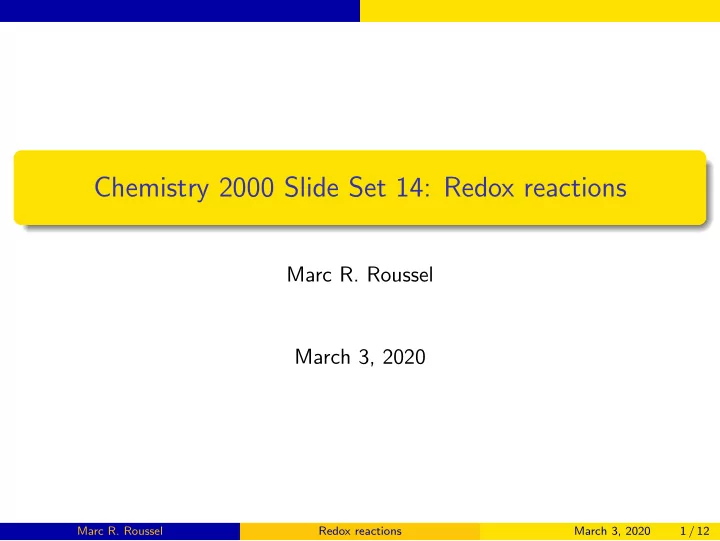

Chemistry 2000 Slide Set 14: Redox reactions Marc R. Roussel March 3, 2020 Marc R. Roussel Redox reactions March 3, 2020 1 / 12
Review: Oxidation states The oxidation state of an atom in a molecule is a charge calculated assuming that bonds are purely ionic. Calculation of oxidation states: 1 The sum of the oxidation states in a molecule is equal to the charge. 2 In a bond between two identical atoms, the electrons are equally shared. 3 In any other bond, we “give” all the shared electrons to the more electronegative atom. � oxidation � � valence electrons � � � electrons in = 4 − state of neutral atom ionized structure Marc R. Roussel Redox reactions March 3, 2020 2 / 12
Example: Determine the oxidation states of all atoms in the sulfate ion. Answer: Oxidation state of S = 6 Oxidation state of O = − 2 Marc R. Roussel Redox reactions March 3, 2020 3 / 12
Redox reactions Reduction is a gain of electrons by an atom or set of atoms during a chemical reaction. Oxidation is a loss of electrons by an atom or set of atoms. A redox (reduction-oxidation) reaction involves oxidation of some atoms and reduction of others. During a redox reaction, the oxidation states of some atoms increase, while the oxidation states of others decrease. Marc R. Roussel Redox reactions March 3, 2020 4 / 12
Redox reactions Oxidizing and reducing agents If the oxidation state of an atom has increased, it has lost electrons and therefore been oxidized. A species containing an atom that has been oxidized has caused something else to be reduced and so is a reducing agent. If the oxidation state of an atom has decreased, it has gained electrons and therefore been reduced. A species containing an atom that has been reduced has caused something else to be oxidized and so is an oxidizing agent. Marc R. Roussel Redox reactions March 3, 2020 5 / 12
Is the following a redox reaction? CH 4 + 2O 2 → CO 2 + 2H 2 O Oxidation states of reactants: C in CH 4 H in CH 4 O in O 2 − 4 +1 0 Oxidation states of products: C in CO 2 O in CO 2 H in H 2 O O in H 2 O +4 − 2 +1 − 2 O has been reduced. C has been oxidized. Conclusion: Yes, this is a redox reaction. Marc R. Roussel Redox reactions March 3, 2020 6 / 12
Is the following a redox reaction? CO 2 + H 2 O → H 2 CO 3 Oxidation states of reactants: C in CO 2 O in CO 2 H in H 2 O O in H 2 O +4 − 2 +1 − 2 Oxidation states of atoms in product H 2 CO 3 : H C O +1 +4 − 2 Conclusion: No change in oxidation states, therefore not a redox reaction. Marc R. Roussel Redox reactions March 3, 2020 7 / 12
Half-reactions A redox reaction can generally be separated into reduction and oxidation half-reactions. Example: For the reaction Zn (s) + Cu 2+ (aq) → Zn 2+ (aq) + Cu (s) the half-reactions are Cu 2+ (aq) + 2e − → Cu (s) Reduction: Zn (s) → Zn 2+ Oxidation: (aq) + 2e − Marc R. Roussel Redox reactions March 3, 2020 8 / 12
Balancing aqueous redox reactions 1 Separate the half-reactions and balance them for all atoms except O and H. 2 Balance each half-reaction for O by adding H 2 O (l) . 3 Balance each half-reaction for H by adding H + (aq) . 4 Balance each half-reaction for charge by adding electrons. 5 Multiply the half-reactions so that each has the same number of electrons, then add them together. The reaction is balanced for acidic conditions. 6 If the reaction occurs in neutral medium, it is OK to have H + as a product, but not as a reactant. If the reaction occurs in basic medium, there shouldn’t be any H + in the overall reaction. In either of these cases, add OH − to “neutralize” excess H + . Marc R. Roussel Redox reactions March 3, 2020 9 / 12
Example When Na 2 Cr 2 O 7 reacts with KBr in acidic medium, the products are Br 2 and Cr 3+ . Balance the reaction. Answer: Cr 2 O 2 − 7(aq) + 14H + (aq) → 2Cr 3+ (aq) + 6Br − (aq) + 7H 2 O (l) + 3Br 2(aq) Marc R. Roussel Redox reactions March 3, 2020 10 / 12
Example: Reaction in neutral medium If the reaction of the last example had occurred in a neutral (or basic) environment, there would not have been many protons available, so they could not have appeared as reactants. To fix this, add equal numbers of hydroxides to both sides to neutralize the protons. Reaction balanced in neutral (or basic) medium: Cr 2 O 2 − (aq) → 2Cr 3+ 7(aq) + 7H 2 O (l) + 6Br − (aq) + 3Br 2(aq) + 14OH − (aq) Marc R. Roussel Redox reactions March 3, 2020 11 / 12
Example: Fuel cells In a fuel cell, a fuel is oxidized in a controlled manner to produce electricity. Common fuel cells use a basic electrolyte. Find the half-reactions for the methane fuel cell. Answer: CH 4(g) + 8OH − CO 2(g) + 6H 2 O (l) + 8e − → (aq) 2O 2(g) + 4H 2 O (l) + 8e − 8OH − → (aq) Marc R. Roussel Redox reactions March 3, 2020 12 / 12
Recommend
More recommend